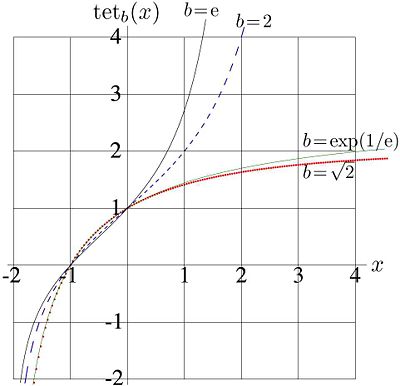Tetration: Difference between revisions
imported>Dmitrii Kouznetsov |
imported>Dmitrii Kouznetsov No edit summary |
||
| Line 7: | Line 7: | ||
<math>x</math>.]] | <math>x</math>.]] | ||
This article is currently [[under construction]]. While, use article from wikipedia http://en.wikipedia.org/wiki/Tetration | This article is currently [[under construction]]. While, use article from wikipedia http://en.wikipedia.org/wiki/Tetration | ||
Tetration is fastly growing [[mathematical function]], which was introduced in XX century and suggested for representation of huge numbers in [[mathematics of computation]]. However, up to year 2008, this function is not considered as elementary function, it is not implemented in [[programming languages]] and it is not used for the internal representation of data, at least in the in commercial software. | |||
==Definiton== | ==Definiton== | ||
For real <math>b>1</math>, Tetration <math>F=\mathrm{tet}_b</math> on the base <math>b</math> is function of complex variable, which is [[holomorphic]] at least in the range | For real <math>b>1</math>, Tetration <math>F=\mathrm{tet}_b</math> on the base <math>b</math> is function of complex variable, which is [[holomorphic]] at least in the range | ||
| Line 15: | Line 18: | ||
: <math> F\!\big(z^*\big) = F\big(z\big)^*</math> | : <math> F\!\big(z^*\big) = F\big(z\big)^*</math> | ||
at least within range <math> \Re(z)>-2 </math>. | at least within range <math> \Re(z)>-2 </math>. | ||
==Etymology== | |||
Creation of word '''tetration''' is attributed to Englidh mathematician [[Reuben Louis Goodstein]] | |||
<ref name="term"> | |||
"TETRATION, a term for repeated exponentiation, was introduced by Reuben Louis Goodstein". | |||
Earliest Known Uses of Some of the Words of Mathematics, | |||
http://members.aol.com/jeff570/t.html</ref> | |||
<ref name="good">{{cite journal | |||
|author= [[Reuben Louis Goodstein|R.L.Goodstein]] | |||
|title=Transfinite ordinals in recursive number theory | |||
|journal=Journal of Symbolic Logic | |||
|volume=12 | |||
|year=1947}} | |||
</ref>. This name indicates, that this operation is fourth (id est, [[tetra]]) in the hierarchy of operations after summation, multiplication, and exponentiation. In pronciple, one can defind "pentation", "sexation", "septation" in the simlar manner, although tetration, perhaps, already has growth fast enough for the requests of XXI century. | |||
==Real values of the arguments== | ==Real values of the arguments== | ||
| Line 52: | Line 70: | ||
\right. | \right. | ||
</math> | </math> | ||
==Piecewice tetration== | ==Piecewice tetration== | ||
Revision as of 06:06, 29 October 2008
This article is currently under construction. While, use article from wikipedia http://en.wikipedia.org/wiki/Tetration
Tetration is fastly growing mathematical function, which was introduced in XX century and suggested for representation of huge numbers in mathematics of computation. However, up to year 2008, this function is not considered as elementary function, it is not implemented in programming languages and it is not used for the internal representation of data, at least in the in commercial software.
Definiton
For real , Tetration on the base is function of complex variable, which is holomorphic at least in the range , bounded in the range , and satisfies conditions
at least within range .
Etymology
Creation of word tetration is attributed to Englidh mathematician Reuben Louis Goodstein [1] [2]. This name indicates, that this operation is fourth (id est, tetra) in the hierarchy of operations after summation, multiplication, and exponentiation. In pronciple, one can defind "pentation", "sexation", "septation" in the simlar manner, although tetration, perhaps, already has growth fast enough for the requests of XXI century.
Real values of the arguments
Examples of behavior of this function at the real axis are shown in figure 1 for values , , , and for . It has logarithmic singularity at , and it is monotonously increasing function.
At tetration approaches its limiting value as , and .
At tetration grows faster than any exponential function. For this reason the tetration is suggested for the representation of huge numbers in mathematics of computation. A number, that cannot be stored as floating point, could be stored as for some standard value of (for example, or ) and relatively moderate value of . The analytic properties of tetration could be used for the implementation of arithmetic operations with huge numbers without to convert them to the floating point representation.
Integer values of the argument
For integer , tetration can be interpreted as iterated exponential:
and so on; then, the argument of tetration can be interpreted as number of exponentiations of unity. From definition it follows, that
and
Relation with Ackermann funcitons
At base , tetration is related to the Ackermann function:
where Ackermann function is defined for the positive integer values of its arguemtnrs with equations
Piecewice tetration
uxp
Analytic tetration
This section is not yet written. There is non-finished draft at User:Dmitrii Kouznetsov/Analytic Tetration.
Inverse of tetration
See also
References
- ↑ "TETRATION, a term for repeated exponentiation, was introduced by Reuben Louis Goodstein". Earliest Known Uses of Some of the Words of Mathematics, http://members.aol.com/jeff570/t.html
- ↑ R.L.Goodstein (1947). "Transfinite ordinals in recursive number theory". Journal of Symbolic Logic 12.
Free online sources
- http://reglos.de/lars/ffx.html , Lars Kindermann. References about Iterative Roots and Fractional Iteration.
- http://math.eretrandre.org/tetrationforum/index.php , Discussion about tetration
- http://tetration.itgo.com/ Tetration site by Andrew Robbins
- http://www.tetration.org/ Tetration site by Daniel Geisler





























